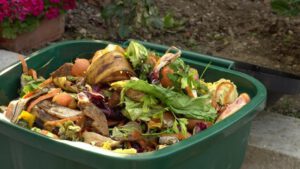What Is Green Waste?
Green waste is organic matter such as garden and park trimmings, hedge cuttings, pruning, grass clippings, twigs, leaves, wood shavings, or other similar materials. Green Waste Mandurah can also include kitchen scraps such as vegetable peelings and coffee grounds.
When buried in landfills, green waste breaks down with anaerobic bacteria to produce methane gas and carbon II oxide. This increases the greenhouse effect and contaminates groundwater.

Yard waste, also known as vegetative or organic waste, consists of leaves, grass clippings, and tree and shrub trimmings. It’s one of the largest components of municipal solid waste by volume, but only a small portion ends up in landfills.
Many communities collect yard waste as part of their green waste recycling program. In such cases, residents place the material in a brown bin or in a paper lawn and leaf bag, and it’s picked up on trash day. Once collected, the waste is turned into compost that can be used to fertilize plants.
Keeping these materials out of landfills reduces the need for chemical fertilizers, cuts down on greenhouse gas production (methane is the second most potent greenhouse gas after carbon dioxide), and keeps native plants from being overtaken by invasive species that can choke out their habitats and starve out animals higher up the food chain. Depending on the specific program, the material may be shredded and mixed with other organic waste to create renewable energy or used in the creation of a soil amendment product.
While it’s okay to include most yard waste in a home compost pile, some things should go straight into the trash. In particular, weeds and diseased plants should not be put in a compost heap, as they can poison the plants they’re paired with. In addition, sticks and thick stems should never be placed in a compost pile, as they can take too long to break down and contaminate the rest of the batch.
Some municipalities offer curbside pickup for yard waste, or you can haul the waste to a composting facility yourself. In either case, it’s important to use the right container for the job. Metal, plastic and glass should not be included in the yard waste container, as they will contaminate the final product. In addition, the liners in some paper bags can leave behind a sticky residue, so residents should use reusable containers. Finally, yard waste can’t be placed in single-stream recycling bins, as this could contaminate the other recyclables.
Food scraps are one of the largest components of trash sent to landfills and incinerators. When buried, these organic waste materials decompose without oxygen to create methane, a potent greenhouse gas that is 25 times more powerful than carbon dioxide over a 20-year period. By diverting food waste from landfills and incinerators and recycling it into compost, we can return these vital resources to the soil where they belong.
The most common method of food scraps diversion is through home composting. To start a home compost pile, purchase or reuse a kitchen scraps container of your choice (you can even keep a food scraps pail in the freezer). Empty your container into a transportation bin when full and bring to a Food Scraps Drop Spot location. Alternatively, you can compost in your yard by setting out a backyard bin and filling it with green waste (leaves, grass clippings and food scraps) and brown waste (dry leaves, paper and cardboard). It’s important to add two or three times the volume of browns to the volume of greens, and to turn the compost regularly for best results.
If you do not wish to compost in your own yard, you can place your food scraps in a curbside collection bin or in the Food Scraps Drop Spot at Transfer Station. The Food Scraps Drop Spot is open Monday, Thursday, Friday and Saturday during Transfer Station hours.
Food scraps can also be brought to a commercial compost facility where they are converted to nutrient-rich soil amendment through a natural process of decomposition. This helps conserve landfill space, reduces greenhouse gas emissions and supports local agricultural economies. Food scraps can also be sent to an anaerobic digester for conversion to renewable energy in the form of biogas, a clean-burning fuel that reduces greenhouse gases and sulfur dioxide.
If you are unable to compost at home, you can donate food scraps to a local community garden or farm through the Food Rescue Locator. These organizations and groups work to redirect surplus food that would otherwise be wasted, and they can use it to grow fresh food for those in need.
Household hazardous waste, or HHW, is the discarded, unused or leftover portion of household products that contain flammable, toxic, corrosive or reactive chemicals and cannot be thrown away in the regular trash. It’s the kind of stuff that builds up in your garage, shed or basement — oil-based paints and solvents, gasoline, pesticides, herbicides, pool chemicals, corrosives, batteries, fluorescent bulbs, propane cylinders, cleaners and other home and yard care items. When improperly disposed of, these products can contaminate drinking water supplies and cause environmental harm. Pouring them down drains can damage plumbing systems, while burying or burning them releases dangerous fumes into the air and can poison soil, plants and water. In addition, sanitation workers and firefighters can be exposed to health hazards when handling these chemicals.
Luckily, most communities offer ways to safely dispose of HHW. EPA-approved disposal programs are often available at retail stores like Home Depot, Best Buy or auto repair shops. Your local recycling center may also accept HHW for processing. Typically, these programs can recycle liquids and solids, although they may not be permitted to accept large quantities of certain types of materials, such as batteries or oil, that are too hazardous to handle.
If you have HHW, you can bring it to a municipal HHW collection facility or an authorized HHW collection event, which are typically one- or two-day events where residents can drop off their unwanted household chemical products at a central location. Check with your municipality to find a list of facilities and locations, as well as the type of HHW they accept.
To reduce the amount of HHW you generate, try using less hazardous cleaning products and replacing chemical-based garden treatments with natural alternatives. Also, consider purchasing reusable plastic containers for your cleaners and storing them in the garage or shed so they’re easier to transport when it’s time to take them to a collection site. This will reduce the risk of them leaking, spilling or igniting during transportation to the facility. For more information on HHW, visit the EPA’s website here.
Commercial waste is created by companies, including offices, restaurants, hotels, and stores. It also includes waste from the manufacturing and construction industries. It is a very large category of waste, with many different types of material that can be included in it. It can include everything from paper and cardboard to food scraps, metals, and more. While this type of waste can be found all over the country, it is particularly common in areas with large numbers of retail businesses.
There are several ways to help reduce commercial waste, including tracking waste levels and educating employees on proper disposal procedures. Posting thorough and uniform signage throughout the property is an important step, as well as sending emails to company-wide staff about how they can help with waste reduction efforts. It is also possible to create an employee “green team” that can work with the company to devise and implement sustainable waste reduction strategies.
Another way to reduce commercial waste is to reuse items rather than throwing them away. This can be as simple as encouraging employees to bring their own reusable mugs to the office. It can also involve reusing materials in new and interesting ways. For example, old soup tins can be turned into stationery storage and organisers. Other items, such as plastic bags and bottles, can be used to create cleaning products.
When it comes to recycling commercial waste, it is important to have a strong partnership with your waste management provider. There are a number of legal requirements and procedures that need to be followed when disposing of this type of waste, so working with a reputable company is crucial.
If you are looking for a way to cut down on your commercial waste, contact a highly-qualified and experienced waste disposal specialist. They will be able to discuss your individual needs and provide you with a range of options that will help you reduce and recycle your commercial waste. They can also help you choose the right size and type of bins and dumpsters to ensure that all your waste is properly sorted and collected.




